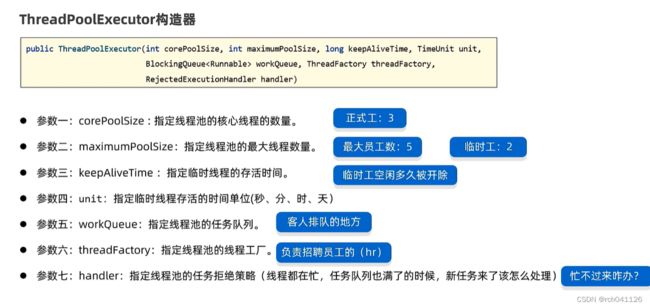认识线程池


如何创建线程池

方法一:使用ExecoutorService的实现类ThreadPoolExecutor创建一个线程池对象

创建线程池对象的例子
ExecutorService pool = new ThreadPoolExecutor(3, 5, 8,
TimeUnit.SECONDS, new ArrayBlockingQueue<>(4), Executors.defaultThreadFactory(),
new ThreadPoolExecutor.AbortPolicy());
线程池的注意事项

线程池处理Runnable任务


package com.itheima.d5;
import java.util.concurrent.*;
public class TheadPoolTest {
public static void main(String[] args) {
//1、通过ThreadPoolExecutor创建一个线程池对象
ExecutorService pool = new ThreadPoolExecutor(3, 5, 8,
TimeUnit.SECONDS, new ArrayBlockingQueue<>(4), Executors.defaultThreadFactory(),
new ThreadPoolExecutor.AbortPolicy());
Runnable target = new MyRunnable();
pool.execute(target);//线程池会自动创建一个新线程,自动处理者个任务,自动执行的
pool.execute(target);//线程池会自动创建一个新线程,自动处理者个任务,自动执行的
pool.execute(target);//线程池会自动创建一个新线程,自动处理者个任务,自动执行的
pool.execute(target);//复用前面的核心线程
pool.execute(target);//复用前面的核心线程
//创建临时线程
pool.execute(target);
pool.execute(target);
//拒绝新任务
pool.execute(target);
pool.shutdown();//等着线程池的任务全部执行完毕后,再关闭线程池
pool.shutdownNow();//立即关闭线程池,不管任务是否之心完毕
}
}
package com.itheima.d5;
public class MyRunnable implements Runnable{
@Override
public void run() {
//任务是干什末的
System.out.println(Thread.currentThread().getName() + "打印666");
try {
Thread.sleep(1000);
} catch (InterruptedException e) {
e.printStackTrace();
}
}
}
线程池处理Callable任务

package com.itheima.d5;
import java.util.concurrent.*;
public class ThreadPoolTest2 {
public static void main(String[] args) throws Exception {
//1、通过ThreadPoolExecutor创建一个线程池对象
ExecutorService pool = new ThreadPoolExecutor(3, 5, 8,
TimeUnit.SECONDS, new ArrayBlockingQueue<>(4), Executors.defaultThreadFactory(),
new ThreadPoolExecutor.AbortPolicy());
//2、使用线程处理Callable任务
Future f1 = pool.submit(new MyCallable(100));
Future f2 = pool.submit(new MyCallable(200));
Future f3 = pool.submit(new MyCallable(300));
Future f4 = pool.submit(new MyCallable(400));
System.out.println(f1.get());
System.out.println(f2.get());
System.out.println(f3.get());
System.out.println(f4.get());
}
}
package com.itheima.d5;
import java.util.concurrent.Callable;
public class MyCallable implements Callable {
private int n;
public MyCallable(int n){
this.n = n;
}
//2、重写call方法
@Override
public String call() throws Exception {
//描述线程的任务,返回线程执行返回后的结果。
//需求:1-n的和返回
int sum = 0;
for (int i = 1; i <= n; i++) {
sum += i;
}
return Thread.currentThread().getName() + "1到n的和" + sum;
}
}
方法二:Executor工具类实现线程池

package com.itheima.d5;
import java.util.concurrent.*;
public class ThreadPoolTest2 {
public static void main(String[] args) throws Exception {
//1、通过ThreadPoolExecutor创建一个线程池对象
// ExecutorService pool = new ThreadPoolExecutor(3, 5, 8,
// TimeUnit.SECONDS, new ArrayBlockingQueue<>(4), Executors.defaultThreadFactory(),
// new ThreadPoolExecutor.AbortPolicy());
//1-2 通过Executor创建一个线程对象。
ExecutorService pool = Executors.newFixedThreadPool(3);
//计算密集型任务:核心线程数量 = CPU的核数 + 1
//IO密集型任务:核心线程数量 = CPU的核数 * 2
//2、使用线程处理Callable任务
Future f1 = pool.submit(new MyCallable(100));
Future f2 = pool.submit(new MyCallable(200));
Future f3 = pool.submit(new MyCallable(300));
Future f4 = pool.submit(new MyCallable(400));
System.out.println(f1.get());
System.out.println(f2.get());
System.out.println(f3.get());
System.out.println(f4.get());
}
}










